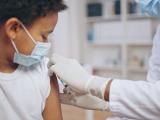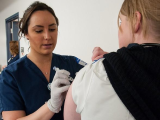Jun 24, 2010 (CIDRAP News) – Aiming to close some of the gaps in protection against the pandemic H1N1 virus expected to circulate this fall, a federal vaccine advisory group today recommended that children aged 6 months to 9 years who haven't received at least one dose of monovalent pandemic vaccine receive two doses of the upcoming season's trivalent vaccine.
The Centers for Disease Control and Prevention's (CDC's) Advisory Committee on Immunization Practices (ACIP) made the recommendation at its meeting today after seeing the most recent immunogenicity data for the pandemic vaccine. Though it was 62% protective among all age-groups after one dose, rates were lower in younger children. Some CDC experts said this supports the recommendation for a 2-dose, prime-boost pandemic immunization strategy for children 6 months to 9 years old.
ACIP members, however, were not unanimous in their recommendation, which passed on a 10-5 vote. Some experts argued in favor of keeping the current recommendation for the seasonal flu vaccine, which stipulates that all children aged 6 months to 9 years who have never been vaccinated should receive two doses of vaccine, with the second dose administered about a month after the first. The 2010-11 seasonal flu vaccine for the Northern Hemisphere contains a pandemic H1N1 component, plus Perth H3N2 and Brisbane influenza B strains.
Those who favored leaving the current recommendation unchanged reasoned that it already applies to many children and that changing the wording could confuse clinicians and parents while yielding little public health benefit. The CDC routinely adopts ACIP's recommendations.
The committee also advised that the age-group receive two doses of the seasonal flu vaccine if parents or clinicians are unsure about the child's pandemic vaccination status.
In other influenza vaccine developments, ACIP members heard detailed safety reports from CDC and outside experts who are involved with pandemic H1N1 vaccine monitoring systems. The safety monitoring systems haven't detected any worrisome signals, and they continue to look closely at the relative risk of Guillain-Barre syndrome.
Carol Baker, MD, who chairs the ACIP and is a pediatrics professor and virologist at Baylor College of Medicine in Houston, said the data show overwhelming evidence for the safety of the pandemic vaccine, which should reassure ACIP members as well as members of the public who were watching the meeting today on a CDC Webcast.
Meanwhile, the CDC is closely monitoring developments in Australia surrounding reports of febrile seizures in young children who have received the seasonal flu vaccine made by Australia-based CSL Ltd. Michael McNeil, MD, MPH, with the CDC's immunization safety office, told the group that CDC is also collaborating on animal studies of the CSL vaccine to determine if there's a problem.
A review of flu-vaccine safety data has uncovered no problems with the pandemic and seasonal vaccines CSL has made for the US market, he said. The Southern Hemisphere's seasonal flu vaccine contains the same components as that being made for the Northern Hemisphere. The CSL trivalent vaccine is an inactivated split-virus product that does not include an adjuvant.
In May Australia suspended seasonal flu vaccination for healthy children younger than 5 after state and federal investigations showed higher-than-expected rates of fever and convulsion after immunization in that age group. CSL pulled the vaccine from the market, but so far investigations have found no problem with the vaccine.
Anthony Fiore, MD, MPH, medical epidemiologist at the CDC, said early projections reveal that if everything goes smoothly, flu vaccine manufacturers will produce a record 170 million seasonal flu vaccine doses for the US market this year. "So far everything is on track," he said.


















